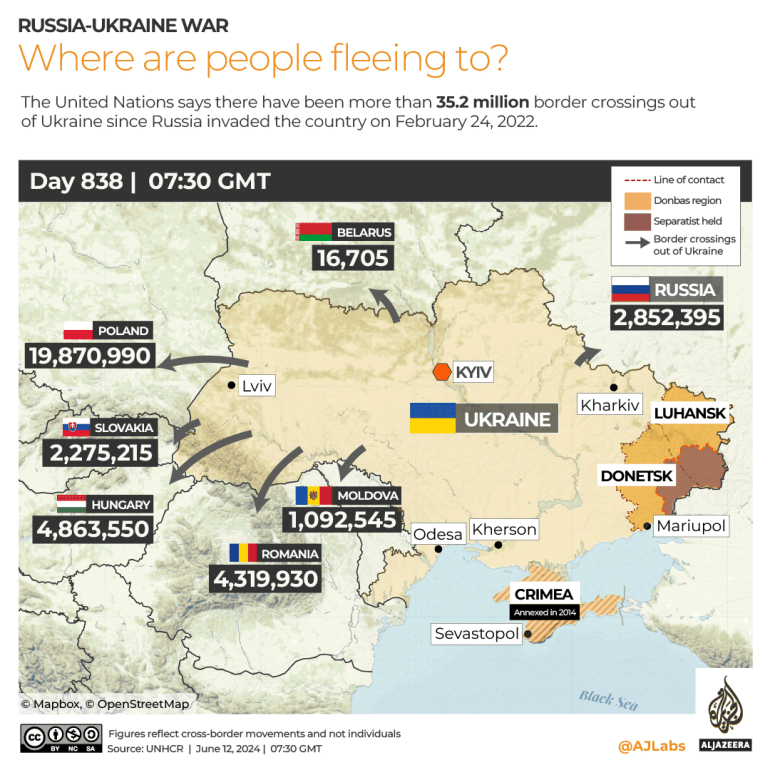At the same time, Russia sought to project power far beyond its borders, sending a flotilla to Cuba, which conducted missile drills along the way and threatened to disseminate long-range weapons to Western adversaries.
On the ground, Russia’s incursion in Ukraine’s northern Kharkiv region appeared to have stalled, as forces spearheading two separate initiatives in Vovchansk and north of Lyptsi made no new gains.
Ukrainian military officials have described that May 10 incursion as an effort to distract their forces from the defence of Chasiv Yar, a key settlement in Donetsk, on the eastern front. Here, Russian forces did make constant incremental gains throughout the past week, but the Khortytsia Group of forces defending this position said Russian forces were not operating inside Chasiv Yar.
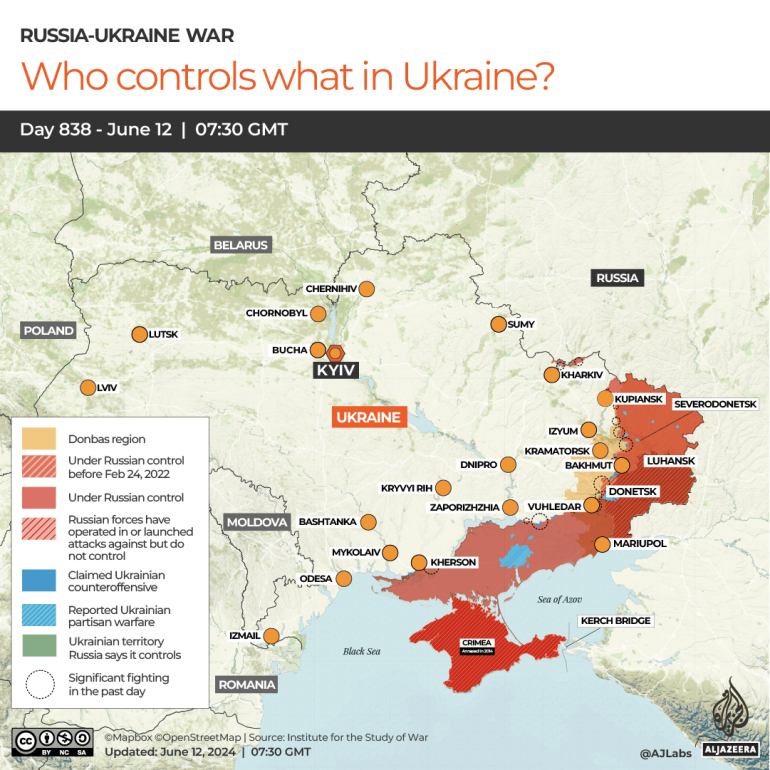
Visual evidence suggested Russian forces were still 700-800 metres east of the Siverskyi Donets-Donbas Canal, a waterway that runs around the eastern edge of Chasiv Yar.
A separate attempted incursion north of Sumy on June 9 advanced about 700m into Ukraine and appeared ineffective since it had “not established a significant or enduring presence in this area,” according to the Institute for the Study of War, a Washington-based think tank.
Ukraine’s regional military administration in Sumy ordered the evacuation of eight villages within 10km (6.2 miles) of the Russian border.
Complicating Russian logistics
A recent change in allied policy towards Ukrainian weapons use appeared to have complicated Russian logistics in the past week.
In late May, the United States and Germany joined France and the United Kingdom in allowing Ukraine to use their weapons inside Russia, in response to the new Kharkiv offensive.
On Monday, the Ukrainian partisan group Atesh, which operates in occupied Crimea, said Russian authorities had begun to move air defence systems to the Russian border region of Belgorod, “which creates a security threat in Crimea, leaving it without proper coverage”.
Ukraine used US-made Army Tactical Missiles (ATACMs) to further weaken Crimea’s air defences that day. Its general staff said their forces had destroyed the main radar of an S-400 air defence battery in Dzhankoi, and the radars of S-300 batteries in Yevpatoria and Chernomorsk, all in northern and western occupied Crimea. Without the radar, the accompanying missile launchers cannot target their missiles.
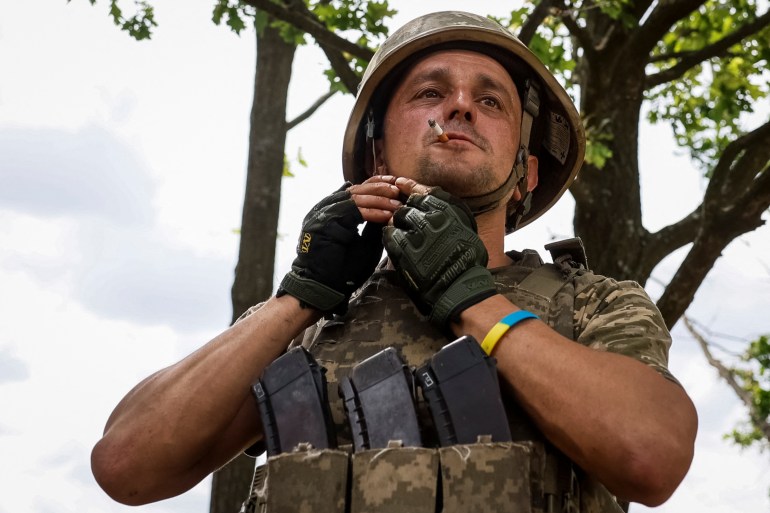
Crimean air defence acts as a shield for the Russian region of Krasnodar Krai and the Russian naval port of Novorossiysk immediately to its east, which was considered a relatively safe haven after repeated Ukrainian strikes on the port of Sevastopol in Crimea.
But in early June, the Russian Black Sea Fleet moved some 18 ships out of Novorossiysk. Ukrainian navy spokesman Dmytro Pletenchuk said Russian authorities realised the ships were sitting ducks.
On Saturday, the Ukrainian Navy reported that seven of those Russian ships were in the Sea of Azov – possibly to protect the Kerch Bridge, which connects Krasnodar Krai to Crimea.
Russia used the bridge on June 8 to transport fuel to Crimea – something it had not done since March, favouring a ferry crossing next to the bridge instead. But Ukraine used US weapons to hit the Russian side of the Kerch ferry crossing on May 31, as soon as geographic restrictions were lifted, complicating Russian logistics.
The bridge’s vulnerability to attack has been known since October 2022, when Ukraine first struck it with a truck bomb, and it proved vulnerable to Ukrainian naval drones last July. In the past few days, Russia has placed barges on either side of the bridge as additional protection from naval drones.
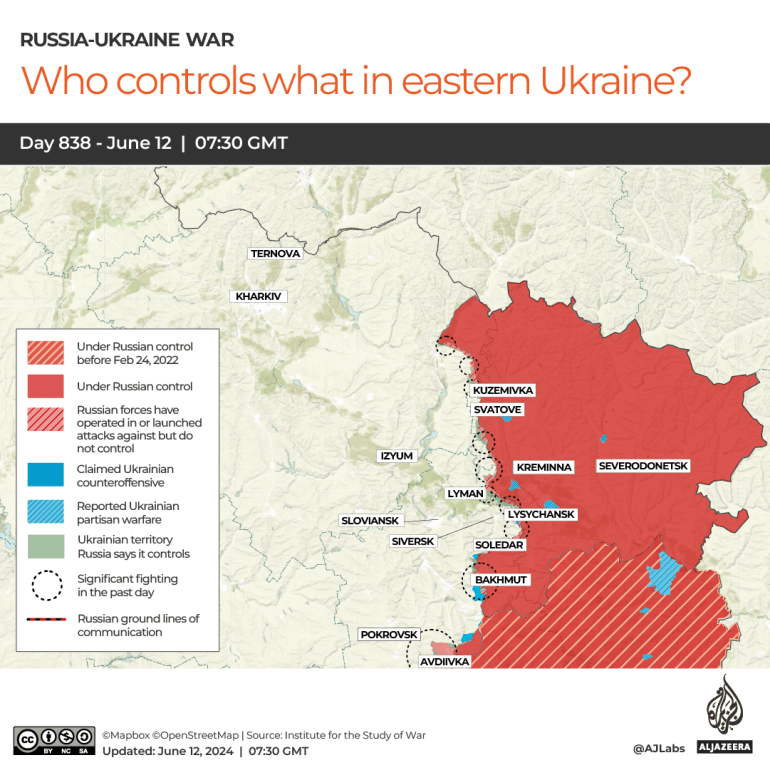
Whereas the UK and France have not publicly restricted the use of their weapons anywhere on Russian soil, the US and Germany have allowed their use only in response to incoming fire and only in Kharkiv.
The ISW was critical of this policy, saying it had “removed a maximum of 16 percent of Russia’s ground sanctuary”, compared with the range of territory in Belgorod, Kursk and Bryansk regions that could be struck using US-made High Mobility Army Rocket systems (HIMARS), and called on the administration to give Ukraine a free hand.
Russian President Vladimir Putin told reporters at the Saint Petersburg International Economic Forum that providing Western adversaries with long-range weapons would be a “symmetrical response” to the lifting of Ukraine’s prohibition from striking Russian soil with allied weapons. He also threatened to use nuclear weapons.
In addition to the lifting of geographic restrictions, Ukraine is to receive F-16 fighter jets this year.
One report said it could expect 60 decommissioned jets from Denmark, Norway and the Netherlands. Ukraine, which still operates Soviet aircraft, has said it needs twice that many to protect its airspace, but on June 6 French President Emmanuel Macron announced he will send French Mirage 2000-5 fighters to Ukraine, without specifying how many or when.
Ukraine sounded less than thrilled.
“Like all modern aircraft, the Mirage 2000 can effectively perform assigned combat missions. It can be both air and ground strikes. The aircraft is quite modern, but the F-16 remains a priority,” said Ukrainian Air Force spokesman Ilya Yevlash the following day.
Speaking to French television networks on the eve of celebrations marking the 80th anniversary of the Normandy landings that ended World War II, Macron also said France would train a battalion of Ukrainian troops (4,500) on French soil.
Striking deep inside Russia
Ukraine does have a free hand when it comes to its own domestically produced weapons, and it continued to use these to strike military and energy targets in Russia, as it has done since the beginning of this year.
Ukrainian drones struck refineries in Belgorod and Rostov on June 6. Two days later, its drones struck Russia’s Mozdok military base in North Ossetia, Georgia territory Russia occupied in August 2008. And Ukraine hit a Russian command post in Belgorod with an unspecified weapon on June 9.
The most prestigious hit came on June 8.
Ukraine’s military intelligence (GUR) claimed to have damaged a Russian Sukhoi-57 multirole fighter. It published satellite images purporting to show the plane surrounded by scorch marks on the tarmac at Akhtubinsk airfield in Astrakhan region, 589km (366 miles) from the contact line.
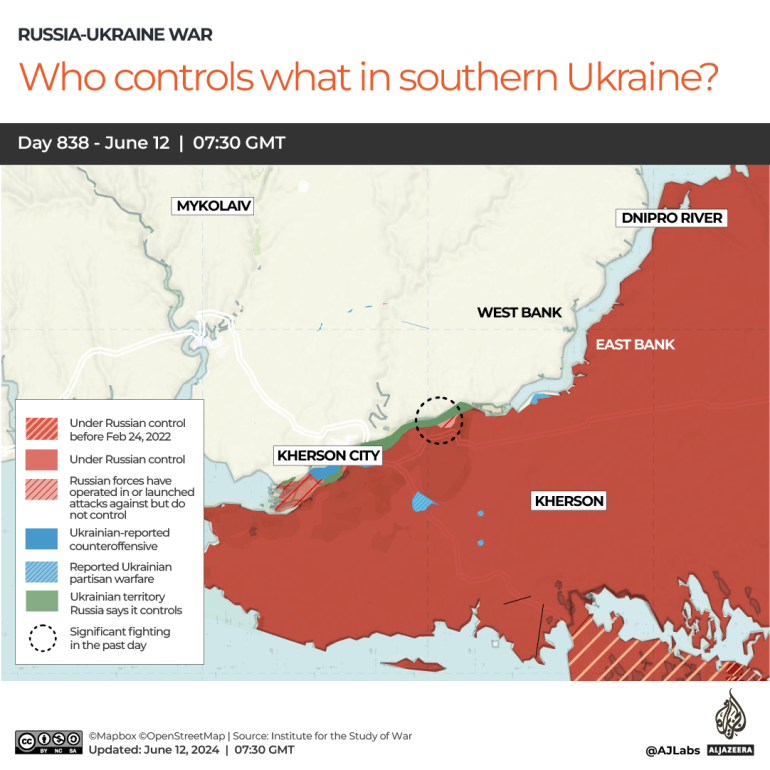
The Su-57 is Russia’s most advanced military combat aircraft, and the strike would be the first damage to this type of aircraft in the Ukraine war.
“Images dated 8 June reveal craters from the explosion and distinct fire marks caused by the strike,” said GUR. It said Russia has an estimated six Su-57s in active service, with another six under construction. “There are data that continue to be refined. There is preliminary information that there could be two Su-57 aircraft affected,” said a GUR spokesperson a day later on a telethon. “There is also information about irretrievable losses and wounded among the personnel of the occupiers.”
Ukraine said the planes had been used to launch Kh-59 and Kh-69 missiles into Ukrainian territory.
Energy losses in Russia, Ukraine
Russia continued to target Ukraine’s energy infrastructure – on Friday Ukraine’s air force said it shot down 48 out of 53 Shahed drones Russia launched targeting Ukrainian energy infrastructure. It also shot down five X-101/X-555 missiles.
Russia has used combinations of drones and missiles to devastate Ukraine’s power infrastructure during the past winter.
Ukrainian Prime Minister Denys Shmyhal said on Friday that Russia had damaged or destroyed 73 percent of the country’s power plants. The Financial Times said Russia had reduced Ukraine’s pre-war installed electricity generating capacity of 55GW to just 20GW.
Russia, too, was experiencing problems with energy – and not just from the refineries Ukraine has been knocking offline, which have reportedly reduced refining capacity by at least 14 percent.
A Stockholm arbitration court on Wednesday ruled that Germany’s leading gas importer could demand enormous damages from Russia for undelivered gas. The company, Uniper, was in litigation with Russia’s state gas supplier, Gazprom, over who was responsible for the non-delivery of gas through the Nordstream 2 pipeline, which was to have started operating in 2022, when it was blown up by unknown saboteurs.
The court ruled that Uniper may cancel its long-term supply contracts with Gazprom and demand 13 billion euros ($14bn) in damages from the Russian company.
Gazprom has run into other problems recently. The Financial Times reported that Putin and Chinese leader Xi Jinping disagreed last month on a sale price for Russian gas to China, with Xi demanding prices near the subsidised domestic Russian rates. That disagreement has stalled the Power of Siberia 2 pipeline, which Gazprom was to have started building to China.
Largely due to the war in Ukraine and the loss of sales to Europe, Gazprom posted a $6.9bn loss last year, its largest in a quarter-century. If the Power of Siberia 2 pipeline does not begin operating in 2029, the FT reported, Gazprom’s profits are forecast to drop by a further 15 percent.
